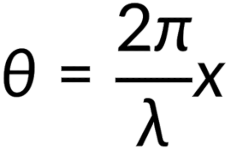16.3:
Equations of Wave Motion
Waves can be described by the motion and position of the particles of the medium through which they move.
If we graph the vertical height of the wave to its position, we see that every particle in the medium oscillates up and down in a simple harmonic motion with the same frequency.
The equilibrium position of the wave is along a straight line and considered to be the x-axis of a coordinate system.
Consider a particle of the medium in which the wave moves. It displaces from the equilibrium position to a certain height in the positive and negative direction of the y-axis in a period T. The wave motion is sinusoidal and is translating in the positive x-direction as time progresses.
The value of particle displacement from the equilibrium position is a function of both position and time and is known as a wave function.
The plus and minus signs indicate whether the wave moves in the negative or positive x-direction, respectively.
16.3:
Equations of Wave Motion
Mathematically, the motion of a wave can be studied using a wavefunction. Consider a string oscillating up and down in simple harmonic motion, having a period T. The wave on the string is sinusoidal and is translated in the positive x-direction as time progresses. Sine is a function of the angle θ, oscillating between +A and −A and repeating every 2π radians. To construct a wave model, the ratio of the angle θ and the position x is considered.

From the ratio, using the value of θ, and multiplying the sine function with amplitude A, we can model the y-position of the string as a function of position x.

The wave on the string travels with a constant velocity and moves a distance equal to vt in time t, so we can modify the wave function using this. Further, multiplying by the term 2π/λ simplifies the equation.

Recall the expressions for wave number and angular frequency, which modify the first and second terms of the above equation, respectively. Hence the reduced expression for the wavefunction of a simple harmonic wave on a string is obtained.

An angle φ that corresponds to the initial phase of the wave is added to the wave function. It is an indicator of the initial position of the particle just before the start of wave motion and is used to determine various wave parameters.
This text is adapted from Openstax, University Physics Volume 1, Section 16.2: Mathematics of Waves.
